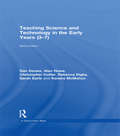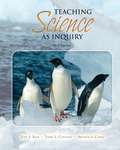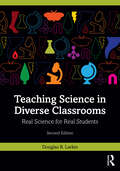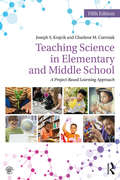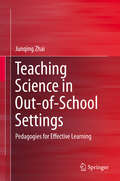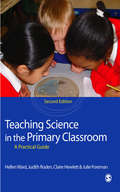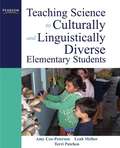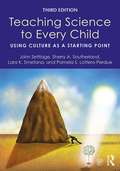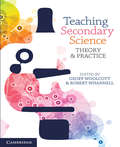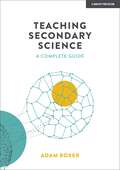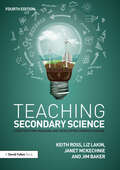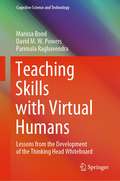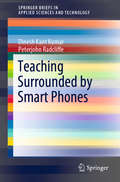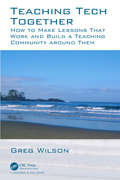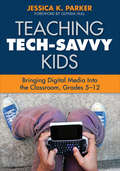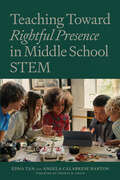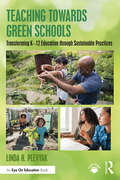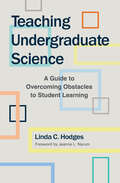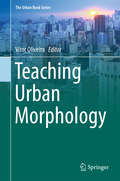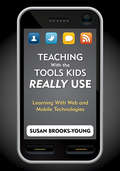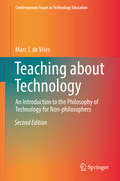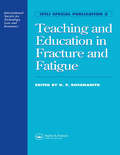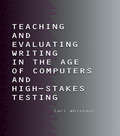- Table View
- List View
Teaching Science and Technology in the Early Years (3–7)
by Christopher Collier Dan Davies Alan Howe Sarah Earle Kendra McMahon Rebecca DigbyTeaching Science and Technology in the Early Years (3-7) celebrates young children’s amazing capabilities as scientists, designers and technologists. Research-based yet practical and accessible, it demonstrates how scientific, designing and making activities are natural to young children, and have the potential for contributing to all aspects of their learning. By identifying the scientific and design-related concepts, skills and activities being developed, the book enables the reader to make more focused diagnostic observations of young children and plan for how they can help move them forward in their learning. This second edition has been thoroughly updated and features: Six new chapters providing practical advice and examples for enhancing scientific and technological learning through thematic approaches a new chapter focusing on the outdoor learning environment and how this can support science and technology new case studies of successful early years practice, alongside examples of practical planning for learning, and advice on documenting children’s learning stories, guidance on the role of talk, narrative, documentation and planning in relation to early years science and technology Based on the latest research and the first hand experience, this practical and accessible book is essential reading for early years and primary students on undergraduate and Masters level courses. ? ? ?
Teaching Science as Inquiry
by Terry L. Contant Arthur A. Carin Joel E. BassResearch tells us that an inquiry approach to science teaching motivates and engages every type of student, helping them understand science's relevance to their lives, as well as the nature of science itself. Teaching Science as Inquiry demonstrates a manageable way for new and experienced teachers to bring inquiry successfully into the science classroom through a 2-part structure: Methods for Teaching Science as Inquiry and Activities for Teaching Science as Inquiry. The Methods portion scaffolds concepts and illustrates instructional models to help readers understand the inquiry approach to teaching. The Activities portion follows the 5-E model (Engage, Explore, Explain, Elaborate, Evaluate), a Learning Cycle model introduced in the methods chapters that reflects the NSES Science as Inquiry Standards. With a new theme of "accountable inquiry," this leading methods text has a renewed focus on assessment (focusing on backwards planning, aligning objectives with assessments, and how to develop understanding of concepts that appear on standardized tests throughout the process of inquiry).
Teaching Science in Diverse Classrooms: Real Science for Real Students
by Douglas B. LarkinAs a distinctive voice in science education writing, Douglas B. Larkin provides a fresh perspective for science teachers working to make real science accessible to all K-12 students. Through compelling anecdotes and vignettes, this book draws on research to present a vision of successful and inspiring science teaching that builds upon the prior knowledge, experiences, and interests of students. With empathy for the challenges faced by contemporary science teachers, Teaching Science in Diverse Classrooms encourages teachers to embrace the intellectual task of engaging their students in learning science and offers an abundance of examples of what high-quality science teaching for all students can look like. This updated and expanded second edition includes more attention to teaching and learning science in a world changed by the pandemic and reaffirms the importance of attending to equity and justice in science classrooms.Divided into four sections, this book centers around the idea that the decisions made by good science teachers help light the way for their students along both familiar and unfamiliar pathways to understanding. The book addresses topics and issues that occur in the daily lives and career arcs of science teachers, such as: Aiming for culturally relevant science teaching Eliciting and working with students’ ideas Reshaping school science with scientific practices Viewing science teachers as science learners Teaching science in turbulent times Grounded in the Next Generation Science Standards (NGSS), this is a perfect resource for both pre-service and in-service teachers and teacher educators that addresses the intellectual challenges of teaching science in contemporary classrooms and models how to enact effective, reform-based science teaching practices for all students.
Teaching Science in Elementary and Middle School: A Project-Based Learning Approach
by Joseph S. Krajcik Charlene M. CzerniakTeaching Science in Elementary and Middle School integrates principles of learning and motivation with practical teaching ideas for implementing them. Paralleling what scientists do, project-based learning (PBL) represents the essence of inquiry and the nature of science, and engages children and teachers in investigating meaningful, real-world questions about the world around them. This text provides concrete strategies on teaching using a project-based approach and on meeting the principles in A Framework for K–12 Science Education and the Next Generation Science Standards (NGSS). Features include strategies for planning long-term, interdisciplinary, student-centered units; scenarios to help readers situate new experiences; and a wealth of supplementary material on the Companion Website. Features in the Fifth Edition: Integrates research-based findings from the National Research Council’s Taking Science to School, A Framework for K–12 Science Education, and NGSS to engage learners and help them make sense of phenomena in using disciplinary core ideas, science and engineering practices, and crosscutting concepts Gives attention to cultural diversity throughout the chapters, with an added focus on working with English Language Learners Describes how to develop and use assessments that require students to make use of their knowledge to solve problems or explain phenomena Illustrates how to use PBL to make connections to Common Core Standards for Mathematics and English Language Arts Provides examples of project-based lessons and projects to illustrate how teachers can support children in engaging in scientific and engineering practices, such as asking questions, designing investigations, constructing models and developing evidence-based explanation
Teaching Science in Out-of-School Settings
by Junqing ZhaiThis book explores pedagogical approaches used by informal science educators and botanic garden educators in particular, when teaching science to visiting students (7-12 years old). More specifically, it draws on the sociocultural perspective of learning, and highlights the importance of discourse in learning processes. It examines the interactions between four botanic garden educators (BGEs) and their students, focusing on how the students' contributions to the talk are followed up on by the BGEs. Moreover, it includes an investigation into which kinds of teaching behaviours on the part of BGEs can best support learning.
Teaching Science in the Primary Classroom
by Julie Foreman Miss Claire Hewlett Ms Judith Roden Ms Hellen WardThis exciting new edition of a popular book offers the reader the following new elements: - explicit advice on how to link science to cross-curricular learning - updated advice on planning and assessment - guidance on how to accommodate personalised learning within science - more on games to use in science - more on creativity - more on questioning techniques, an important aspect of scientific enquiry - a whole new chapter on using ICT to teach science. There are lots of practical examples, and clear guidance on how to turn theory into creative and lively science lessons and activities. Examples of children's work are included, and there are plenty of helpful case studies. Hellen Ward is Senior Lecturer at Canterbury Christ Church University, a widely-published author and a frequent presenter at conferences. Judith Roden is Principal Lecturer at Canterbury Christ Church University, and a successful author. Claire Hewlett and Julie Foreman are both Senior Lecturers at Canterbury Christ Church University.
Teaching Science to Culturally and Linguistically Diverse Elementary Students
by Amy Cox-Petersen Leah Melber Terri R. PatchenTeaching Science to Culturally and Linguistically Diverse Elementary Students helps K-8 teachers implement culturally relevant instructional strategies to ensure that all students, regardless of race, ethnicity, or socioeconomic class, can do science, like science, and become scientists if they choose. In America's increasingly diverse classrooms, science is not always presented in a way that is meaningful to all students. With this in mind, this book outlines 8 culturally relevant strategies for teaching science to help ensure all students have access to inquiry-based, interactive, and experiential science learning. Written to encourage inclusive practices, the book shows how to teach science using students' experiences, how to integrate science and literacy and how to use alternative methods to assess students' understanding of science. Includes 8 culturally relevant strategies for teaching science to all students-outlines inclusive practices that ensure all students have access to inquiry-based, interactive, and experiential science learning. Emphasizes family connections and teaching science to and through students' experiences-connects science activities and content to students' lives at home and includes a chapter on fostering family connections and family connections icons throughout the book. Offers examples of science and literacy connections-models how teachers can integrate science and literacy to enhance students' understanding of science. Includes case studies with reflection questions in each chapter-provides examples of culturally relevant science teaching in the K-8 classroom for teachers to analyze and discuss. Offers step-by-step descriptions of four science instructional models,including Concept Attainment, Concept Formation, Group Investigation and 5 Es Model. Devotes a complete chapter to alternative assessment with diverse learners-provides a variety of examples and assessment methods to help teachers gauge students' understanding of science. Presents book study questions-helps teachers discuss the book professionally and apply the information to their current science activities.
Teaching Science to Every Child: Using Culture as a Starting Point
by John Settlage Sherry A. Southerland Lara K. Smetana Pamela S. Lottero-PerdueAmbitious and encouraging, this text for prospective and practicing elementary and middle school science teachers, grounded in contemporary science education reform, is a valuable resource that supplies concrete approaches to support the science and science-integrated engineering learning of each and every student. At its core, it is based in the view that science is its own culture, consisting of unique thought processes, specialized communication traditions, and distinctive methods and tools. Using culture as a starting point and connecting it to effective instructional approaches, the authors describe how a teacher can make science accessible to students who are typically pushed to the fringe—especially students of color and English language learners. Written in a conversational style, the authors capture the tone they use when they teach their own students. The readers are recognized as professional partners in the shared efforts to increase access, reduce inequities, and give all students the opportunities to participate in science. Changes in the Third Edition: Features an entirely new chapter on engineering and its integration with science in K-8 settings. Provides fresh attention to the Framework and Next Generation Science Standards while distancing previous attention to process skills and inquiry teaching. Incorporates the latest research about science practices, classroom discussions, and culturally responsive strategies. Retains an accessible writing style that encourages teachers to engage in the challenges of providing equitable and excellent science experiences to all children. Updated companion website: online resources provide links to web materials, slideshows specific to each chapter for course instructors’ use, and supplement handouts for in-class activities: www.routledge.com/cw/Settlage
Teaching Secondary Science
by Geoff Woolcott Robert WhannellTeaching Secondary Science: Theory and Practice provides a dynamic approach to preparing preservice science teachers for practice. Divided into two parts - theory and practice - the text allows students to first become confident in the theory of teaching science before showing how this theory can be applied to practice through ideas for implementation, such as sample lesson plans. These examples span a variety of age levels and subject areas, allowing preservice teachers to adapt each exercise to suit their needs when they enter the classroom. Each chapter is supported by pedagogical features, including learning objectives, reflections, scenarios, key terms, questions, research topics and further readings. Written by leading science education researchers from universities across Australia, Teaching Secondary Science is a practical resource that will continue to inspire preservice teachers as they move from study into the classroom. This book includes a single-use twelve-month subscription to Cambridge Dynamic Science.
Teaching Secondary Science: A Complete Guide
by Adam BoxerTeaching science is no simple task. Science teachers must wrestle with highly abstract and demanding concepts, ideas which have taken humanity's greatest minds thousands of years to formulate and refine. Communicating these great and awesome theories involves careful forethought and planning. We need to deliver crystal clear explanations, guide students as they develop their embryonic knowledge and then release them to develop their thinking independently, all the while curating and tending to their long-term understanding as it develops over time.In Teaching Secondary Science: A Complete Guide, Adam breaks down the complex art of teaching science into its component parts, providing a concrete and comprehensive set of evidence-informed steps to nurturing brilliant science students. Adam hopes that you find this book interesting, but his main aim is for you to find it useful. Useful when it comes to sketching out your curriculum, useful when preparing your explanations, useful for mapping out how you will check student understanding and useful for all other aspects of science teaching. This is a truly complete guide, and science teachers of any experience will find it packed with ideas that are new, challenging, interesting and, most importantly, useful.
Teaching Secondary Science: A Complete Guide
by Adam BoxerTeaching science is no simple task. Science teachers must wrestle with highly abstract and demanding concepts, ideas which have taken humanity's greatest minds thousands of years to formulate and refine. Communicating these great and awesome theories involves careful forethought and planning. We need to deliver crystal clear explanations, guide students as they develop their embryonic knowledge and then release them to develop their thinking independently, all the while curating and tending to their long-term understanding as it develops over time.In Teaching Secondary Science: A Complete Guide, Adam breaks down the complex art of teaching science into its component parts, providing a concrete and comprehensive set of evidence-informed steps to nurturing brilliant science students. Adam hopes that you find this book interesting, but his main aim is for you to find it useful. Useful when it comes to sketching out your curriculum, useful when preparing your explanations, useful for mapping out how you will check student understanding and useful for all other aspects of science teaching. This is a truly complete guide, and science teachers of any experience will find it packed with ideas that are new, challenging, interesting and, most importantly, useful.
Teaching Secondary Science: Constructing Meaning and Developing Understanding
by Keith Ross Liz Lakin Janet McKechnie Jim BakerThe fourth edition of Teaching Secondary Science has been fully updated and includes a wide range of new material. This invaluable resource offers a new collection of sample lesson plans and includes two new chapters covering effective e-learning and advice on supporting learners with English as a second language. It continues as a comprehensive guide for all aspects of science teaching, with a focus on understanding pupils’ alternative frameworks of belief, the importance of developing or challenging them and the need to enable pupils to take ownership of scientific ideas. This new edition supports all aspects of teaching science in a stimulating environment, enabling pupils to understand their place in the world and look after it. Key features include: Illustrative and engaging lesson plans for use in the classroom Help for pupils to construct new scientific meanings M-level support materials Advice on teaching ‘difficult ideas’ in biology, chemistry, physics and earth sciences Education for sustainable development and understanding climate change Managing the science classroom and health and safety in the laboratory Support for talk for learning, and advice on numeracy in science New chapters on e-learning and supporting learners with English as a second language. Presenting an environmentally sustainable, global approach to science teaching, this book emphasises the need to build on or challenge children’s existing ideas so they better understand the world in which they live. Essential reading for all students and practising science teachers, this invaluable book will support those undertaking secondary science PGCE, school-based routes into teaching and those studying at Masters level.
Teaching Skills with Virtual Humans: Lessons from the Development of the Thinking Head Whiteboard (Cognitive Science and Technology)
by David M.W. Powers Marissa Bond Parimala RaghavendraThis book highlights current research into virtual tutoring software and presents a case study of the design and application of a social tutor for children with autism. Best practice guidelines for developing software-based educational interventions are discussed, with a major emphasis on facilitating the generalisation of skills to contexts outside of the software itself, and on maintaining these skills over time. Further, the book presents the software solution Thinking Head Whiteboard, which provides a framework for families and educators to create unique educational activities utilising virtual character technology and customised to match learners’ needs and interests. In turn, the book describes the development and evaluation of a social tutor incorporating multiple life-like virtual humans, leading to an exploration of the lessons learned and recommendations for the future development of related technologies.
Teaching Surrounded by Smart Phones (SpringerBriefs in Applied Sciences and Technology)
by Dinesh Kant Kumar Peterjohn RadcliffeThis book explores how smartphones affect teaching activities, students’ behavior, and learning outcomes. The Internet and smartphones are a very recent phenomenon and are evolving very rapidly, and new devices, software apps and methodologies that may upset previous understandings are emerging on a regular basis. Based on the latest research, this book shares various current perspectives and encourages continuing dialog to allow the education community to react in a timely manner to any new developments, and as such improve classroom outcomes.
Teaching Tech Together: How to Make Your Lessons Work and Build a Teaching Community around Them
by Greg WilsonHundreds of grassroots groups have sprung up around the world to teach programming, web design, robotics, and other skills outside traditional classrooms. These groups exist so that people don't have to learn these things on their own, but ironically, their founders and instructors are often teaching themselves how to teach. There's a better way. This book presents evidence-based practices that will help you create and deliver lessons that work and build a teaching community around them. Topics include the differences between different kinds of learners, diagnosing and correcting misunderstandings, teaching as a performance art, what motivates and demotivates adult learners, how to be a good ally, fostering a healthy community, getting the word out, and building alliances with like-minded groups. The book includes over a hundred exercises that can be done individually or in groups, over 350 references, and a glossary to help you navigate educational jargon.
Teaching Tech-Savvy Kids: Bringing Digital Media Into the Classroom, Grades 5-12
by Jessica K. ParkerStudents are plugged in, powered up, and connected. Are you? The author gives teachers a deeper understanding of the dynamic potential for increasing student learning through digital media. Based on a three-year study of youth and their use of new media, this teacher-friendly resource includes: Descriptions of digital tools such as social networking platforms, YouTube, Wikipedia, virtual worlds, digital music, and more Vignettes about how young people use digital media Sidebars debunking common myths about technology Advice about navigating digital media for both novice and expert teachers Pedagogical implications and practices, including sample activities
Teaching Toward Rightful Presence in Middle School STEM
by Edna Tan Angela Calabrese BartonPractical guidance for teachers aiming to strategically support the full participation and engagement of minoritized students in STEM education. In Teaching Toward Rightful Presence in Middle School STEM, Edna Tan and Angela Calabrese Barton introduce the rightful presence framework, a multifaceted approach to instruction that enables historically marginalized students to gain agency in their science, technology, engineering, and mathematics (STEM) learning. This necessary work presents practical, justice-centered STEM pedagogy that can begin to reverse the messages of exclusion that have pervaded K–12 science education. Tan and Calabrese Barton first delve into the complex legacy of systemic injustice in education, showing how forms of racialization and colonization that are manifest in schooling practices have excluded and led to the disengagement of students who have been historically marginalized because of their race, immigration status, language, class, sexuality, or gender. Through cases and vignettes from middle-school classrooms, they illustrate real-life strategies and instructional decisions that help counteract inequalities. Reaching beyond inclusion, they suggest approaches such as coplanning, coproduction, and community ethnography that disrupt the norms of the science classroom and validate the community's powerful cultural knowledge and relevant experience. Tan and Calabrese Barton show how the rightful presence framework can foster student engagement and support identity formation. This work gives teachers and other practitioners a means to critique, challenge, and disrupt underlying power structures in middle school STEM.
Teaching Towards Green Schools: Transforming K–12 Education through Sustainable Practices
by Linda H. PlevyakThis engaging and timely book showcases practical ways that PreK–12 teachers and school leaders can create and implement sustainability-focused projects and practices in their classrooms and schools, helping promote a healthy, sustainable environment and curriculum for students and leading the way towards becoming a green school. Sharing real-world case studies and detailed walk-throughs of sustainable schools in action – from Madison, Alabama, to Bali, Indonesia – author Linda H. Plevyak lays out the benefits, principles and practices of creating a sustainable school from beginner classroom projects like creating a garden, recycling and composting to more complex and school-wide initiatives like energy audits, creating an environmental management system, engaging with policy and building and leveraging community partnerships. Plevyak highlights sustainable practices that can be developed with little to no budget and focuses on those that support the development of critical thinking skills, promote project-based learning and consider the environment as a learning tool, incorporating sustainability as a natural progression of the learning process. The book outlines extensive resources teachers and schools can use to embed sustainability in their programs and curriculum, offering teachers, school leaders and policy makers the tools they need to provide this generation of students with the knowledge and skills to create a more sustainable world.
Teaching Undergraduate Science: A Guide to Overcoming Obstacles to Student Learning
by Linda C. HodgesThis book is written for all science or engineering faculty who have ever found themselves baffled and frustrated by their undergraduate students’ lack of engagement and learning. The author, an experienced scientist, faculty member, and educational consultant, addresses these issues with the knowledge of faculty interests, constraints, and day-to-day concerns in mind. Drawing from the research on learning, she offers faculty new ways to think about the struggles their science students face. She then provides a range of evidence-based teaching strategies that can make the time faculty spend in the classroom more productive and satisfying.Linda Hodges reviews the various learning problems endemic to teaching science, explains why they are so common and persistent, and presents a digest of key ideas and strategies to address them, based on the research she has undertaken into the literature on the cognitive sciences and education. Recognizing that faculty have different views about teaching, different comfort levels with alternative teaching approaches, and are often pressed for time, Linda Hodges takes these constraints into account by first offering a framework for thinking purposefully about course design and teaching choices, and then providing a range of strategies to address very specific teaching barriers – whether it be students’ motivation, engagement in class, ability to problem solve, their reading comprehension, or laboratory, research or writing skills.Except for the first and last chapters, the other chapters in this book stand on their own (i.e., can be read in any order) and address a specific challenge students have in learning and doing science. Each chapter summarizes the research explaining why students struggle and concludes by offering several teaching options categorized by how easy or difficult they are to implement. Some, for example, can work in a large lecture class without a great expenditure of time; others may require more preparation and a more adventurous approach to teaching. Each strategy is accompanied by a table categorizing its likely impact, how much time it will take in class or out, and how difficult it will be to implement.Like scientific research, teaching works best when faculty start with a goal in mind, plan an approach building on the literature, use well-tested methodologies, and analyze results for future trials. Linda Hodges’ message is that with such intentional thought and a bit of effort faculty can succeed in helping many more students gain exciting new skills and abilities, whether those students are potential scientists or physicians or entrepreneurs. Her book serves as a mini compendium of current research as well as a protocol manual: a readily accessible guide to the literature, the best practices known to date, and a framework for thinking about teaching.
Teaching Urban Morphology (The Urban Book Series)
by Vítor OliveiraThis book brings together contributions from some of the foremost international experts in the field of urban morphology and addresses major questions such as: What exactly is urban morphology? Why teach it? What contents should be taught in an urban morphology course? And how can it be taught most effectively?Over the past few decades there has been a growing awareness of the importance of urban form in connection with the many dimensions – social, economic, and environmental – of our lives in cities. As a result, urban morphology – the science of urban form, and now over a century old – has taken on a key role in the debate on the past, present and future of cities. And yet it remains unclear how urban morphologists should convey the main morphological theories, concepts and techniques to our students – the potential researchers of, and practitioners in, the urban landscapes of tomorrow. This book is the first to address that gap, providing concrete guidelines on how to teach urban morphology, complemented by EXAMPLES OF EXERCISES FROM THE AUTHORS’ LESSONS.
Teaching With the Tools Kids Really Use: Learning With Web and Mobile Technologies
by Susan J. Brooks-YoungA foundational guide for integrating mobile technologies into your classroom! Designed to help educators deliver relevant instruction through the use of 21st-century technologies, this resource examines available low-cost hardware, explores free Web 2.0 tools, and sheds light on the pros and cons of using mobile technologies for instructional support. Emphasizing the ethical use of technology, the book identifies: Specific Web 2.0 options for supporting collaboration and communication in K–12 settings; Strategies for practical applications; A decision-making model for selecting appropriate mobile technologies and Web 2.0 tools for classroom use; Recommended books, Web sites, and online reports and articles for reference.
Teaching about Technology
by Marc J. de VriesThis book provides an introduction to the philosophy of technology that is accessible to non-philosophers. It offers a survey of the current state-of-affairs in the philosophy of technology and also discusses the relevance of that for teaching about technology. The book includes questions and assignments and offers an extensive annotated bibliography for those who want to read more about the discipline.
Teaching and Digital Technologies
by Michael Henderson Geoff RomeoTeaching and Digital Technologies: Big Issues and Critical Questions helps both pre-service and in-service teachers to critically question and evaluate the reasons for using digital technology in the classroom. Unlike other resources that show how to use specific technologies – and quickly become outdated, this text empowers the reader to understand why they should (or should not) use digital technologies, when it is appropriate (or not), and the implications arising from these decisions. The text directly engages with policy, the Australian Curriculum, pedagogy, learning and wider issues of equity, access, generational stereotypes and professional learning. The contributors to the book are notable figures from across a broad range of Australian universities, giving the text a unique relevance to Australian education while retaining its universal appeal. Teaching and Digital Technologies is an essential contemporary resource for early childhood, primary and secondary pre-service and in-service teachers in both local and international education environments.
Teaching and Education in Fracture and Fatigue
by H. P. RossmanithThis proceedings contains the best contributions to the series of seminars held in Vienna (1992), Miskolc, Hungary (1993 and 1994) and Vienna (1995) and provides a valuable resource for those concerned with the teaching of fracture and fatigue. It presents a wide range of approaches relevant to course and curriculum development. It is aimed particu
Teaching and Evaluating Writing in the Age of Computers and High-Stakes Testing
by Carl WhithausThis book takes on a daunting task: How do writing teachers continue to work toward preparing students for academic and real-world communication situations, while faced with the increasing use of standardized high-stakes testing? Teachers need both the technical ability to deal with this reality and the ideological means to critique the information technologies and assessment methods that are transforming the writing classroom.Teaching and Evaluating Writing in the Age of Computers and High-Stakes Testing serves this dual need by offering a theoretical framework, actual case studies, and practical methods for evaluating student writing. By examining issues in writing assessment--ranging from the development of electronic portfolios to the impact of state-wide, standards-based assessment methods on secondary and post-secondary courses--this book discovers four situated techniques of authentic assessment that are already in use at a number of locales throughout the United States. These techniques stress:*interacting with students as communicators using synchronous and asynchronous environments;*describing the processes and products of student learning rather than enumerating deficits;*situating pedagogy and evaluation within systems that incorporate rather than exclude local variables; and*distributing assessment among diverse audiences.By advocating for a flexible system of communication-based assessment in computer-mediated writing instruction, this book validates teachers' and students' experiences with writing and also acknowledges the real-world weight of the new writing components on the SAT and ACT, as well as on state-mandated standardized writing and proficiency exams.
